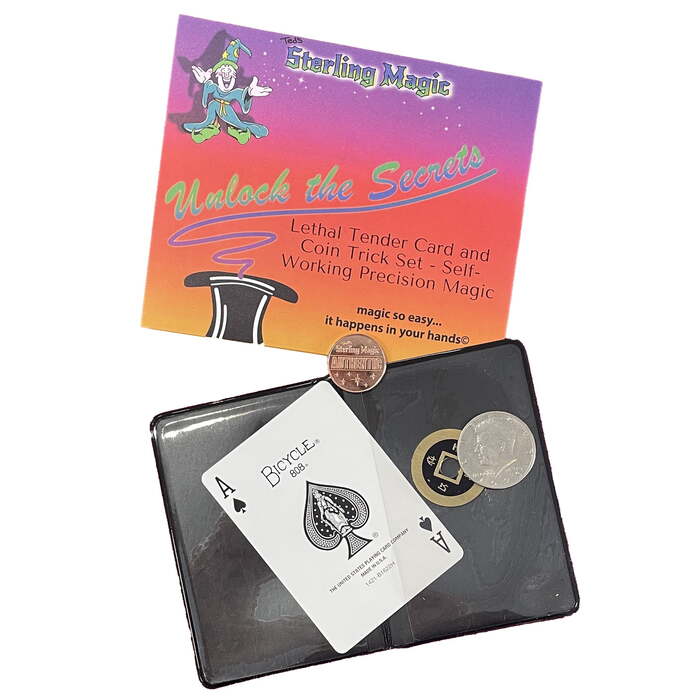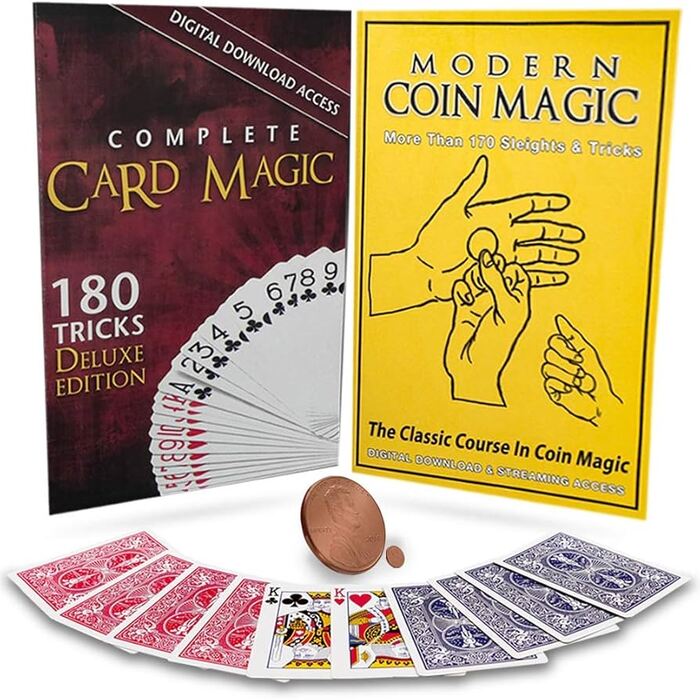Magic has fascinated audiences for centuries, seamlessly blending entertainment and wonder. Central to this allure are the disciplines of card and coin magic. These magical forms enchant us with their precision, mystery, and charm. Both require deft hands, years of practice, and an understanding of human psychology. Thus, magicians use these elements to create seamless spectacles that leave us questioning reality.
The Intricacies of Card Magic
Card magic, also known as cardistry, captivates audiences with its versatility. The cards themselves serve as both tools and symbols. Their universality makes them instantly recognizable, adding to the sense of wonder. The ease with which magicians can carry a deck also means that they can spontaneously conjure magic. Yet, behind the apparent simplicity lies a world of complexity and dexterity.
Basic Card Tricks
Even the simplest card tricks can astound and amaze. Fundamental tricks like the “Pick a Card” trick rely on psychological manipulation and sleight of hand. They involve a spectator selecting a card, then the magician astonishingly reveals it. Another foundational trick is the “Forcing” technique, where the magician subtly manipulates a spectator into choosing a specific card. Achieving this, magicians utilize techniques like “classic force” or the “riffle force.”
Advanced Card Techniques
Advanced card tricks elevate magic into an art form. Card manipulation techniques such as the “Double Lift” enable a magician to deceive the audience easily. In this trick, the magician lifts two cards but presents them as one. Another sophisticated technique is “Card Palming,” where the magician secretly holds a card in their hand. During this, spectators remain unaware, allowing for seamless transitions between tricks. Advanced moves often require copious amounts of practice and precision to master.

The Charm of Coin Magic
Coin magic operates on the principles of stealth, dexterity, and timing. Coins, being everyday objects, add a layer of believability to the illusions. Unlike card magic, which may involve elaborate narratives, coin magic often hinges on brief, stunning moments of surprise. Though coins seem straightforward, they offer endless opportunities for impressive illusions due to their portability and the variety of tricks that can be performed.
Classic Coin Tricks
Certain coin tricks have stood the test of time. “The French Drop” is a staple, where a coin appears to vanish from the fingertips. This trick relies on misdirection and sleight of hand. Another perennial favorite is “Coins Across,” where coins seemingly move from one hand to another, defying logic. The trick’s invisible transitions stun audiences, even those who watch closely.
Modern Coin Manipulation
With the advent of modern magic, coin tricks have become even more sophisticated. Tricks like “Coin Matrix” require multiple coins and cards, creating the illusion of coins jumping positions. Advanced tricks such as “Edge Grip” involve expertly balancing and hiding coins on the edge of one’s palm. These techniques not only require manual dexterity but also immense concentration and fluid movements. Modern magicians continuously innovate, merging traditional tricks with digital technology for interactive performances.
Mastering the Techniques
The journey to mastering card and coin magic is demanding yet rewarding. It necessitates dedication, patience, and a keen understanding of human psychology. Magicians spend years honing their skills to perfect their craft. They must also understand the art of storytelling, creating a narrative that draws the audience in.
Hands-On Practice
Continuous practice is crucial for mastery. Magicians typically start with basic techniques and gradually move on to more advanced maneuvers. Practice sessions often focus on individual aspects, such as dexterity, timing, and misdirection. Repetition builds muscle memory, allowing movements to become second nature. This culminates in seamless performances that leave spectators in awe.
Performative Elements
Beyond technical skills, successful magicians are also consummate performers. Showmanship plays a vital role in elevating tricks from simple demonstrations to captivating performances. Storytelling, humor, and engaging audience interactions are crucial elements. Magicians must exude confidence and charisma, holding the audience’s attention throughout the act. Balancing technical expertise with performative flair transforms a collection of tricks into a magical experience.

Audience Interaction
A key aspect of magic lies in engaging the audience. Creating a rapport enhances the overall impact of the magic. Audience involvement often makes tricks more personal and memorable. It also provides opportunities for improvisation, adding a unique element to every performance.
The Role of Misdirection
Misdirection is a cornerstone of successful magic. This involves diverting the audience’s attention away from the workings of the trick. Magicians achieve this through gestures, eye contact, and patter. For instance, a magician may engage the audience in conversation while executing a crucial move. This ensures the trick remains unnoticed, maximizing the element of surprise. Misdirection requires a profound understanding of human behavior and perception.
Creating Spectacle
Creating a spectacle requires more than just technical skill. It involves constructing a narrative that immerses the audience in the magical experience. Elements like lighting, music, and stage design can amplify the effect. For instance, dramatic lighting can accentuate momentary illusions, making them more dazzling. Music can build tension and excitement, enhancing the overall emotional impact. Stage design can manipulate space and perspective, adding layers of complexity to the performance.
The Psychological Dimension
Understanding the psychological dimension of magic is pivotal. It allows magicians to predict and manipulate audience reactions. This knowledge enhances the effectiveness of illusions, making them more convincing. Techniques like cold reading and mentalism exploit psychological principles, adding an extra layer of wonder.
Exploiting Perceptual Gaps
Magicians often exploit perceptual gaps to create illusions. These gaps arise due to the brain’s mechanisms for processing information. For example, the brain tends to fill in missing details based on expectations. Magicians manipulate these expectations to deceive the audience. Understanding perceptual psychology enables magicians to create more effective illusions.
The Role of Suspense
Suspense plays a vital role in deepening the audience’s engagement. By building anticipation, magicians heighten the impact of the reveal. Suspense is often created through pacing, dramatic pauses, and the gradual escalation of tricks. The longer an audience waits for a reveal, the more impactful it becomes. This emotional buildup turns even simple tricks into memorable experiences.
Modern Innovations
The modern era has seen significant innovations in card and coin magic. Technological advancements have opened new avenues for creating and presenting tricks. Digital magic has emerged as a new genre, blending traditional sleight of hand with modern technology. Additionally, social media platforms have expanded the reach of magic, allowing magicians to share their craft with a global audience.
Digital Magic
Digital magic integrates technology into traditional illusions. Tricks involving smartphones, tablets, and augmented reality have gained popularity. For instance, a magician might make a coin appear inside a smartphone, blurring the lines between physical and digital realms. This fusion of technology and magic holds immense potential for innovative performances.
Social Media and Magic
Social media platforms have revolutionized the way magic is shared and consumed. Magicians can now reach a global audience with just a click. Platforms like YouTube and Instagram have become popular venues for showcasing magic, allowing for interactive and engaging content. Additionally, social media has facilitated a community for magicians, fostering the exchange of ideas and techniques.

The Timeless Appeal
The timeless appeal of card and coin magic lies in its blend of simplicity and complexity. While the tools are everyday objects, the illusions they create are extraordinary. This juxtaposition captures the imagination, creating a sense of wonder that transcends age and culture. The enduring popularity of card and coin magic attests to its unique ability to enchant and entertain.
Universal Accessibility
The universality of cards and coins adds to their magical appeal. These objects are ubiquitous, familiar, and accessible. This means that almost anyone can relate to the tricks performed, enhancing their impact. The simplicity of the tools contrasts with the complexity of the illusions, creating a sense of wonder and intrigue.
The Evolution of Magic
The evolution of card and coin magic demonstrates its adaptability and resilience. Over the centuries, these forms have continuously evolved, incorporating new techniques and technologies. Despite these changes, the essence of magic remains unchanged – the ability to astonish and delight. This blend of tradition and innovation ensures that card and coin magic will continue to captivate audiences for generations to come.
Conclusion
The enduring fascination with card and coin magic lies in its delicate balance of simplicity and complexity. These forms of magic captivate audiences with their skillful execution, psychological insight, and creative presentation. While the tools are everyday objects, the illusions they create are extraordinary, stirring a sense of wonder and delight. The integration of modern technology and social media has further expanded the reach and impact of magic. As magicians continue to innovate and evolve, card and coin magic will undoubtedly continue to enchant and mesmerize. Ultimately, the timeless appeal of magic lies in its ability to remind us of the extraordinary potential within the ordinary and the limitless possibilities of human ingenuity.
